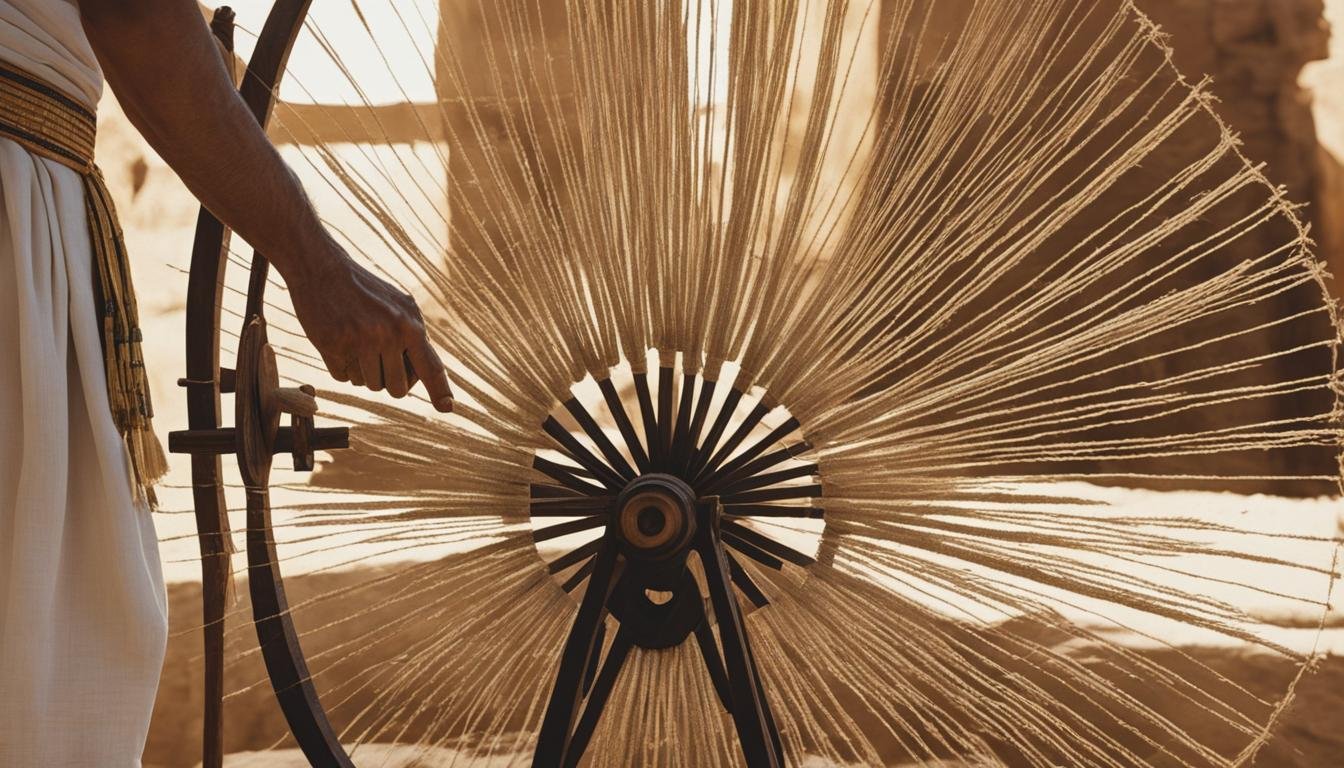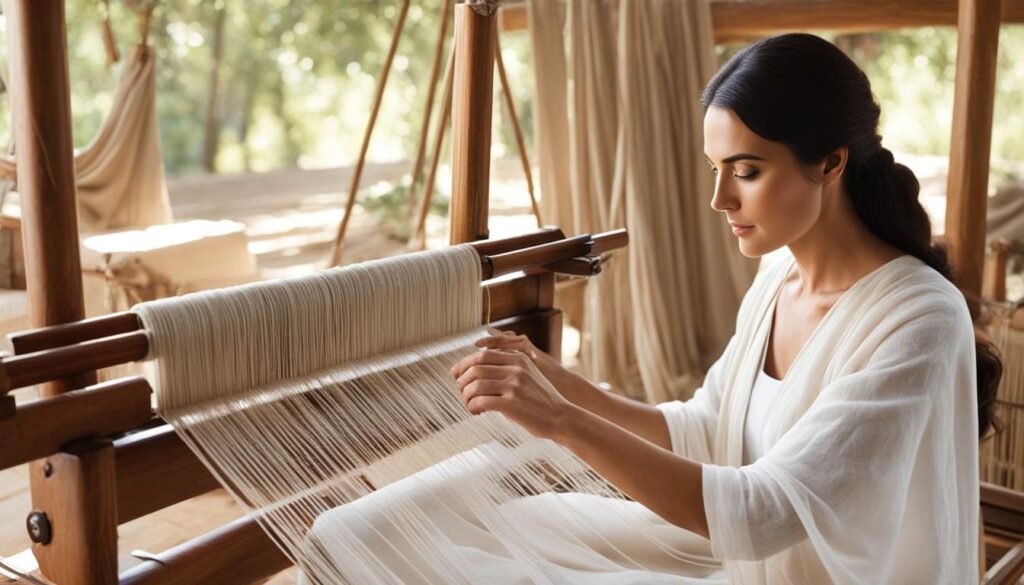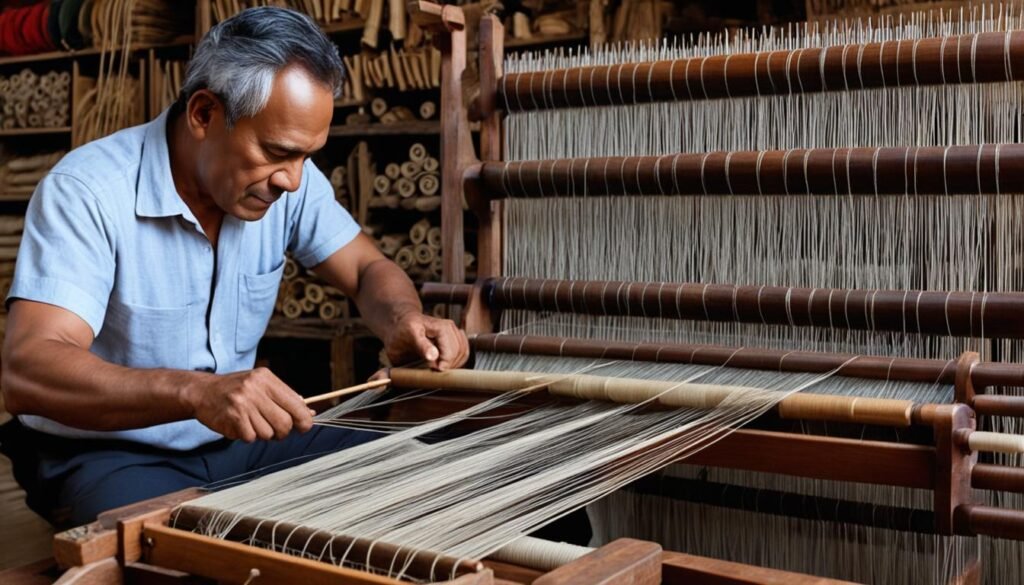Your cart is currently empty!

Unraveling the Rich History of Linen Fabric
Capturing the essence of our cultural heritage and reflecting the progress of civilizations, the history of linen fabric is a testament to human ingenuity and artistic expression. As one of the oldest known ancient textiles, linen unfolds a narrative deeply rooted in various societies across the globe. Originating from the humble flax plant, linen’s impressive journey highlights its timeless significance
Linen, with its distinctive characteristics of strength, breathability, and moisture-wicking properties, has always been preferred in warm climates. But linen is more than just a practical fabric. Its rich narratives embedded in mythologies, folklore, and ancient cultural practices emphasize its integral role in shaping societies and inventing linen-based traditions.
Key Takeaways
- The history of linen fabric dates back to ancient civilizations, making linen one of the oldest known textiles.
- The invention of linen was prompted by the discovery of flax, heralding a milestone in human craftsmanship and agricultural practices.
- Aside from its practical usage, linen holds deep cultural significance, reflected in ancient mythologies, folklore, and religious practices.
- The characteristics of linen, including its strength, breathability, and moisture-wicking properties, have made it a favored choice in warm and humid climates.
- From functional garments to symbolic representations, linen’s versatility underscores its timeless importance in human history.
The Divine Origins of Linen in Ancient Egypt
The historical journey of linen finds its mystical inception in the ancient landscapes of Egypt, deeply rooted in the country’s rich mythology and cultural practices. The origin of linen is often attributed to the ancient Egyptians, who mastered the art of spinning fibers from the flax plant into fine linen threads.
This divine craft was considered a gift of the gods, a sacred tradition that continued to influence the fabric’s use in numerous societal and religious contexts throughout history.
Goddess Isis and the Art of Spinning Linen
In the loom of Egyptian mythology, the goddess Isis holds a prime position as the deity who introduced humans to the delicate craftsmanship of linen. It was believed that Isis, the divine mother, and protector, taught the Egyptians the skill of transforming flax into linen, thus embedding the fabric with a sanctity and reverence that radiated through the echelons of Egyptian society.
This celestial connection with Isis further magnified the fabric’s allure and cultural upbringing, reaffirming linen’s intrinsic value in everyday life and beyond.
Tayet and the Sacred Mummification Rituals
The narrative of linen in ancient Egyptian culture extends to the goddess Tayet, revered for overseeing the sacred act of weaving and the rituals of mummification. Interestingly, the term ‘Tayet’ is thought to be derived from the Egyptian word for a shroud, resonating with the sacred fabric’s principal role in the meticulous mummification process.
The embalmed bodies of Pharaohs and other nobility enshrouded in fine linen wrappings, stand as silent testimonials to the fabric’s implications of purity, rebirth, and eternity. This profound association with mummification underscores the intricate interplay between the origin of linen and the spiritual dimensions that envelop the mortal journey into the afterlife.
Ancient Greece and the Armor of Linen
In the expansive narrative of ancient textiles, the tale of linen takes an extraordinary turn in ancient Greece. Woven into the very fabric of Greek mythology and warfare, it is a testament to the intricate duality of delicate craft and battle-ready resilience this textile has to offer. We observe this through the legendary craft of Penelope and the invention of the formidable linothorax.
Penelope’s Shroud and the Symbolism of Linen
A poignant tale of wit and patience is revealed in Homer’s ancient epic, The Odyssey. The heroine, Penelope, skillfully wove a burial shroud in the daytime while unraveling it at night.
This crafty act of weaving linen, she argued, needed to be completed before choosing among her suitors in the prolonged absence of her husband, Odysseus. This legendary piece of linen symbolizes patience, ingenuity, and cunning, as Penelope cleverly bought time to await her husband’s return.

Linothorax: Combining Linen and Warfare
Moving from the sphere of myths and legends, linen found practical uses on the battlefields of Ancient Greece. The invention of linothorax, a type of armor made by layering linen and glue, heralded an innovative application of this ancient textile.
Esteemed for its high protective quality and lightness, the linothorax was the choice of warriors, including those during the era of Alexander the Great.
Archaeological research suggests that this linen armor could withstand arrows and other weaponry of the time, bearing testament to the unmatched resilience of linen. This linen armor not only shielded the warriors but also subtly embodied the strength of the fabric and the civilization that wielded it.
The Role of Linen in European Folklore
In the rich tapestry of European folklore, linen threads weave a tale filled with enchanted mystery. Creatively used to express artistic narratives and symbolic meanings, this centuries-old textile has made indelible impressions on some of Europe’s most notable mythologies—specifically in the realms of Norse and Celtic traditions.
Norse Mythology: The Celestial Weaving of Frigg
In the frost-tipped pages of Norse mythology, linen finds a majestic reference. It is compellingly associated with Frigg, the venerable Queen of the Æsir and wife to Odin—the Allfather. Known for her prophetic prowess and esteemed as the deity of the sky, she is reputed to weave the clouds themselves from linen.
This celestial weaving, deeply embedded into the roots of Norse lore, resonates with a symbolic connection between linen and the fruits of creation. Indeed, within the context of Norse tradition, the emblem of linen embodies a bridge between mankind and the heavenly realm.
Celtic Traditions: Linen as a Protector and Talisman
Celtic traditions, grounded in the rich soils of Ireland and the British Isles, also celebrate the charm of linen. Not just limited to utility, linen has been known to hold protective qualities and is often endowed with a heightened rank of importance during rituals and ceremonies.
As a talisman, garments made from linen are believed to provide protection from harmful forces. This Irish belief attributes a role to linen as a harbinger of good fortune and a shield against malignant spirits. Hence, linen emerges not just as a humble fabric, but also as a spiritual protector, brimming with cultural relevance.
“The magics of linen thread through the ages, from the celestial weavings of Norse mythology to the protective garbs of Celtic traditions.”
The ancient tales spun around this enchanting fabric exhibit the mystical allure infused into everyday life through the medium of linen. With every warp and weft, this textile continues to illustrate tales steeped in European tradition—making it a treasure trove of cultural narratives, be it Norse mythology or Celtic folklore.
As we unfurl the linen of history, understanding the protective place these garments held in the past empowers us to appreciate the depth of symbolism exhibited in every thread.
| Mythology | God/Goddess | Symbolism of Linen |
|---|---|---|
| Norse | Frigg | Celestial creation |
| Celtic | — | Protection and Talisman |
The History of Linen Fabric: Weaving Through Time
The history of linen fabric is deeply interwoven with the tapestry of global socio-economic development, especially within certain European pockets such as Belgium, Germany, and the Netherlands. Spanning ages, this textile has traveled across geographical borders, both physically and culturally, carving its niche in every dynamic society it touched.

Linen’s tales from medieval times are particularly captivating, with stories of exquisite Flemish linen becoming a coveted possession in various economies. It found a central place in agricultural bases, being symbolic of regional corteges of development.
This everyday textile went on to play a pivotal role in community welfare and collective identity through exclusive regional embroidery styles and textile traditions.
Beyond its distinguished position in artistic and cultural traditions, linen quite substantially impacted the economic growth of societies. The decentralized production of linen preceding the industrialization waves was instrumental in sustaining rural economies and holding up traditional crafts and their inheritors.
The weaving of linen became more than just a craft; it tied communities together, became an avenue of expression, and upheld economic sustenance, crafting a whole new societal fabric.”
Fanning out its versatility, Linen saw varied uses, from being the luxurious damask sought out by nobility for its grandeur, to the practical and durable everyday wear of the working-class. The production and consumption patterns of linen drew out clear socioeconomic stratifications within societies.
Types of Linen Social Strata Uses Damask Linen Nobility Luxurious Garments, Extravagent Tapestries Plain Linen Working Classes Everyday Clothing, Bedding, Artisanal Products In its weaving, linen thus tells a tale of time, capturing the essence of socioeconomic structures, regional identities, and traditional weaving techniques, preserving the roots while evolving to the beat of the ever-changing times.
The Introduction of Cotton and the Shift in Textile Dynamics
The rise of cotton as a staple fabric ushered in a new era that significantly impacted the historical course of linen, primarily shaped by the introduction of cotton and cultural shifts in fashion preferences. Differing textile qualities started to draw a clear line between the roles each fabric played in society.
From Belgium’s Prosperity to the New World’s Wardrobes
Belgium, known for its prosperous linen industry, felt the impacts of this change, which bore implications on a global scale. Easy cultivation and production of cotton, notably after the invention of the cotton gin, saw it being preferred over linen’s crisp texture.
Consumers were drawn to cotton’s soft and pliable qualities, leading to a shift in wardrobe choices around the world. The cotton industry boomed, directly competing with the established textile production of luxury linen and sparking a new economic dynamic.
Textile’s Transition: The Impact of Industrialization
The Industrial Revolution dramatically altered textile production, favoring fabrics that could be mass-produced efficiently. As innovative manufacturing techniques ushered in an era of increased productivity and profitability, the time-consuming process of producing linen was overshadowed by cotton’s rapid proliferation.
This transition saw cotton dominating affordable textiles, redefining the luxury status of linen. This shift powerfully highlights the influence of industrialization on global power structures within the textile industry.
FAQ
What is the history of linen fabric?
The history of linen fabric is ancient and steeped in cultural significance. Originating from the flax plant, it is one of the oldest known textiles derived from a natural source. Over centuries, linen has been woven into the fabric of various cultures, appreciated for its strength, durability, breathability, and unique moisture-wicking properties.
How was linen invented?
Linen was not invented per se, but the skill of spinning flax into linen threads is believed to be passed down by the Egyptian goddess Isis according to ancient mythology. The fabric was used widely in Egypt for both practical uses and in religious and funerary practices, contributing to its profound cultural significance.
What is the significance of linen in ancient Egypt?
The origin of linen in ancient Egypt is tied to mythology. Revered as sacred, it was used in mummification rituals, including the wrapping of Pharaohs. This practice underscored linen’s association with the values of purity and rebirth.
How was linen used in ancient Greece?
In ancient Greece, linen symbolized ingenuity and patience, seen notably in the story of Penelope. It also extended into warfare with the creation of the linothorax, a type of reinforced armor made by layering linen and glue, esteemed for its protective quality.
What is the role of linen in European folklore?
In European folklore, linen carries a mystical charm. Norse mythology revered Frigg, wife of Odin, for weaving the sky itself from linen, signifying its connection to creation and the celestial realm. Celtic traditions held linen in high regard for its purported protective and magical properties, using it in rituals and ceremonies.
How has the history of linen fabric evolved over time?
The history of linen has been interwoven with the development of societies and economies, particularly in European regions such as Belgium, Germany, and the Netherlands. From medieval times to the advent of the industrial revolution, linen has played a significant role in facilitating artistic expression, community well-being, and cultural identity.
How did the introduction of cotton impact the popularity of linen?
The ease of cotton cultivation and production, especially after the invention of the cotton gin, led to a shift in consumer preferences and fashion. Cotton’s softer and more pliable nature differed from the crispness of linen, prompting a global change in wardrobe choices and leading to cotton’s dominance in affordable textiles.
Leave a Reply